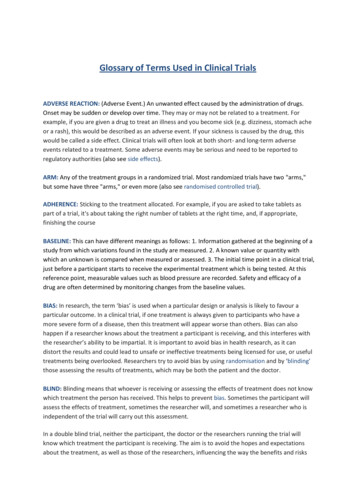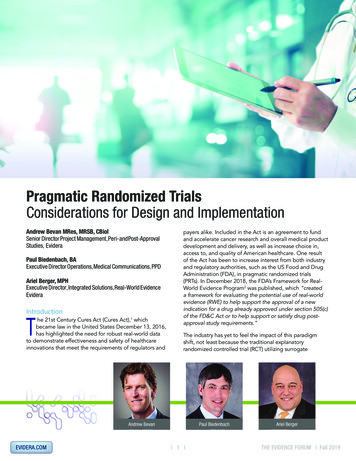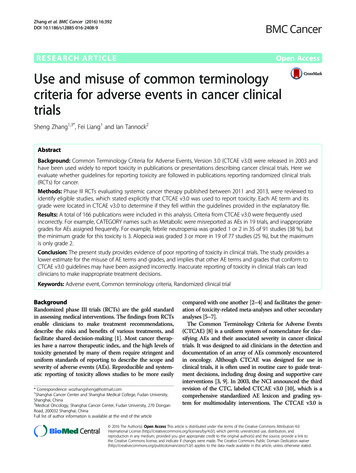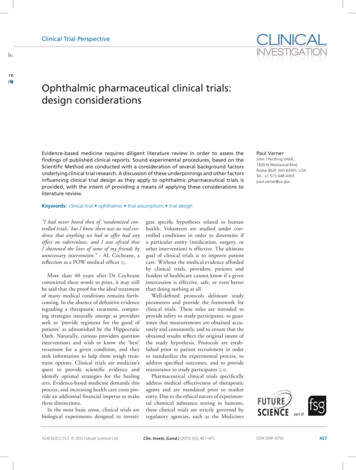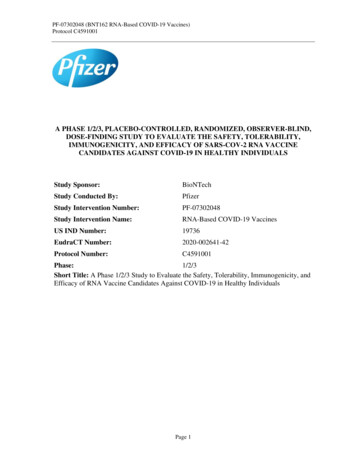
Transcription
ISSN - 0974-2441Vol 6, Issue 3, 2013Review ArticleOVERVIEW OF RANDOMIZED CONTROLLED TRIALSDR. RATHAI RAJAGOPALAN1, DR. PRIYADARSHINI M.DEODURG2, DR. SRIKANTH*21Departmentof Pharmacology, M.S.Ramaiah medical college, MSR Nagar, MSRIT post, Bangalore, 560054, India, 2Department ofPharmacology, Khaja Banda Nawaz institute of medical sciences, Gulbarga, 585104, India.Email: pharmacsrikanth@gmail.comReceived:19 May 2013 , Revised and Accepted:16 June 2013ABSTRACTRandomized controlled trials are considered to be the gold standard in clinical studies to establish level of evidence in medical research. But, theyare not easy to conduct and various other aspects have to be looked into. Randomization offers each enrolled subject equal chance of being allocatedto the intervention and the control groups. Randomized control trial (RCT) is most powerful tool in clinical research. In this, subjects are assignedto different groups of interventions by chance for comparison. RCT is only study design which can help us evaluate a new treatment. By assigningparticipants to different intervention groups by chance, comparison between the interventions groups is made. Purpose of randomization is tomake the treatment groups comparable, eliminates the source of and it ensures that the difference in groups is only due to trial treatments. In thisarticle, we review randomized control trial with special emphasis on various types of randomized controlled trials, their characteristics, the processof randomization, and advantages and drawbacks of randomized controlled trials.Keywords: Randmized controlled trials, study design, randomization, clinical researchINTRODUCTIONRandomized controlled trial is defined as “An epidemiologicalexperiment in which subjects in a population are randomly allocatedinto groups, usually called study and control groups, to receive ornot receive an experimental preventive or therapeutic procedure,maneuver, or intervention. The results are assessed by rigorouscomparison of rates of disease, death, recovery, or other appropriateoutcome in the study and control groups” [1].OutcomeInterventiongroupSTUDYPOUPULATIONFirst published RCT in medicine is credited to Sir A. Bradford Hill[3], an epidemiologist for England’s Medical Research Council.Randomization as a basic principle of experimental design in the1920s was developed by RA Fisher who presented randomization asan essential ingredient of his approach to the design and analysis ofexperiments, validating significance tests predominantly inagricultural research [4].RCTs are now recognized as optimal method for “rationaltherapeutics” in medicine [5]. To improve the reporting of RCTs inthe medical journals, Consolidated Standards of Reporting Trials(CONSORT) Statements were published regularly, the last beingpublished in 2010 by an international group of scientists and editorswhich have become widely accepted to improve the reporting ofRCTs [6].Intervention trials (controlled trials)The term “intervention” refers to treatment and in its much widersense includes prevention strategies, screening programs, diagnostictests, interventional procedures, educational models and the settingin which health care is provided. In a intervention trial primaryexposure under study is applied by the investigator. These are theonly experimental form of epidemiologic studies, though they arealso observational in that subjects remain in their ordinary habitats.In an intervention trial, the investigator decides which subjects areto be exposed and which are not.OutcomeControlgroupThe terms "Randomized Control Trial" and “randomized trial” areoften used synonymously, but some authors distinguish between"Randomized Control Trial" which compare treatment groups withcontrol groups not receiving treatment (as in a placebo-controlledstudy), and "randomized trials" which can compare multipletreatment groups with each other [2].No outcomeNo outcomeDirection of enquiryFig. 3: Outline of an intervention trial [7]Nonrandomized controlledA study where participants have been assigned to the treatment,procedure, or intervention alternatives by a method that is notrandom. The investigator defines and manages the alternatives. Thisis an experimental study in which people are allocated to differentinterventions using methods that are not random. In these studies,allocation to different groups is done arbitrarily. This kind of studydesign may sometimes overestimate the advantages of onetreatment over other [8].Non-randomized trials are a type of quasi-experimental design. Nonrandomized clinical trials are sometimes referred to as “quasiexperimental” clinical trials or “non-equivalent control group”designs because the characteristics of subjects in non-randomizedgroups will tend to be non-equivalent. The estimation ofintervention effects in non-randomized clinical trials may be biasedif group differences in subject characteristics are not controlled forin the data analysisWhen is it appropriate to use a non-randomized trial design? When the act of random allocation may reduce theeffectiveness of the intervention (Occurs when theeffectiveness of the intervention depends on theparticipant’s active participation which is influenced by theirbeliefs and preferences)When it would be unethical to do random allocation
Dr. Srikanth et al.Asian J Pharm Clin Res, Vol 6, Issue 3, 2013, 32-38 When it is impractical to do random allocation (e.g. cost orconvenience factors)When there are legal or political obstacles to randomallocation Randomized controlled trialRandomized controlled trials (RCTs) are considered the “goldstandard” in medical research since they offer the best answersabout the effectiveness of different therapies or interventions. Theimportant aspect of this study design is that the patients arerandomly assigned to the study all groups that help in avoiding biasin patient allocation-to-treatment that a physician might be subjectto. It also increases the probability that the differences between thegroups can be attributed only to the treatment(s) under study [8].Randomized Controlled Clinical TrialIncludes Diagnostic, Therapeutic, Prophylactic, Devices, Procedures,Regimens, Protocols. Concerned with evaluating therapeutic agent,mainly drugs e.g. Evaluation of nitrates in reducing cardiovascularmortalityA simplified diagram of a Randomized Controlled ClinicalTrial is depicted in figure 1, and the flow chart according toCONSORT statement for reporting a RCT is depicted in figure 2.Study populationInclusion/exclusioncriteriaRandomized to two ormore groupsTypes of Randomized Controlled Trials Randomized Controlled Clinical Trial: Diagnostic,Therapeutic, Prophylactic, Devices, Procedures, Regimens,ProtocolsRandomized Controlled Field TrialPreventive TrialRisk Factor TrialCessation experimentsTrial of etiologic agentsEvaluation of health systemInterventiongroupoutcomeControl groupoutcomeFig. 1- Example of a Randomized Controlled Clinical Trial [7]Fig. 2: Flow diagram of the progress through the phases of a parallel randomized trial of two groups [6]Randomized Controlled Field Trial: It is similar to an RandomizedControlled Clinical Trial except that the intervention is preventiveand not therapeutic. These are usually preventive trials in which theefficacy of a preventive intervention such as a new vaccine is testedin one study group and the other group receives a placebo orstandard. As they are usually conducted in the community, the termused is Randomized Controlled Field Trial.Preventive Trials: Trial of primary preventive measures e.g.Vaccines. Analysis of preventive trials must result in clear statementabout benefits to community, risk involved and cost to health33
Dr. Srikanth et al.Asian J Pharm Clin Res, Vol 6, Issue 3, 2013, 32-38Risk Factor Trials: Investigator intervenes to interrupt the usualsequence in the development of disease for those individuals whohave risk factor for developing the diseasee.g. Primary prevention of CHD using simvastatin to lower serumcholesterolCessation Experiment: An attempt is made to evaluate thetermination of a habit which is considered to be causally related todiseasee.g. Cigarette smoking and lung cancerTrials of Etiological Agents: To confirm or refute an etiologicalhypothesisEvaluation of Health Services: Domiciliary treatment of primarypulmonary tuberculosis was as effective as more costlier hospital orsanatorium treatmentControls in Randomized Controlled Clinical TrialFDA classifies clinical trial control groups into six types [9].Placebo Concurrent ControlIn a placebo-controlled trial, subjects are randomly assigned to a testtreatment or to an identical-appearing treatment that does notcontain the test drugNo-treatment Concurrent ControlIn a no treatment-controlled trial, subjects are randomly assigned totest treatment or to no (i.e., absence of) study treatment. Theprincipal difference between this design and a placebo-controlledtrial is that subjects and investigators are not blind to treatmentassignment. Weaknesses of RCT Active (Positive) Concurrent ControlIn an active control (or positive control) trial, subjects are randomlyassigned to the test treatment or to an active control treatment. Multiple Control GroupsLewis EJ, Hunsicker LG, Clarke WR, et al: Renoprotectiveeffect of the angiotensinreceptor antagonist irbesartan inpatients with nephropathy due to type 2 diabetes. N Engl JMed 345:851-860, 2001Brenner BM, Cooper ME, de Zeeuw D, et al: Effects oflosartan on renal and cardiovascular outcomes in patientswith type 2 diabetes and nephropathy. N Engl J Med345:861-869, 2001Different types of randomized studies as follows [10-12]Randomized Controlled Trials Classified According to theDifferent Aspects of Interventions Evaluated (Based on outcomeof interest) External Control (Including Historical Control)An externally controlled trial compares a group of subjects receivingthe test treatment with a group of patients external to the study,rather than to an internal control group consisting of patients fromthe same population assigned to a different treatment. The externalcontrol can be a group of patients treated at an earlier time(historical control) or a group treated during the same time periodbut in another settingSubjects are often a highly selected group (selected forwillingness to comply with treatment regimen, level ofhealth, etc.) and volunteers may differ from population ofinterest (i.e., generalizability may suffer).Not suitable for rare outcomesNot suitable for outcomes requiring long or extensivefollow-upAdherence/withdrawal issuesLimitations of external validityNarrowing of the studied question Sometimes impossibleor impractical to conductComplex, Expensive, time consuming, sometimes ethicallyquestionable.Examples of Experimental StudiesDose-response Concurrent ControlIn a randomized, fixed-dose, dose-response trial, subjects arerandomized to one of several fixed dose groups. Subjects may eitherbe placed on their fixed dose initially or be raised to that dosegradually, but the intended comparison is between the groups ontheir final doseProvides strongest evidence for causality in relation totemporality and control for unknown "confounders"Allows comparison of multiple outcomesSimilar distribution of baseline characteristics incomparison groupsFulfills the basic assumption of statistical hypothesis testsProtection against confounders, both known andunknownSimilar distribution of baseline characteristics incomparison groups Explanatory or pragmatic trials - Explanatory trials aredesigned to know whether new interventions work and ifit works how it works. Pragmatic trials on the other hand,are designed not only to determine whether theintervention works but also to describe all theconsequences of the intervention and its use undercircumstances corresponding to clinical practice [13].Efficacy or effectiveness trials - Efficacy refers towhether an intervention works in people who receive it,whereas effectiveness refers to whether an interventionworks in people to whom it has been offered [14].Phase 1, 2, 3, and 4 trialsIt is often possible and advantageous to use more than one kind ofcontrol in a single study, e.g., use of both an active control andplacebo. Similarly, trials can use several doses of test drug andseveral doses of an active control, with or without placebo. Thisdesign may be useful for active drug comparisons where the relativepotency of the two drugs is not well established, or where thepurpose of the trial is to establish relative potency.Based on hypothesisStrengths of RCTAccording to the number of participants Most like an experimentThe only effective method known to control selection biasAble to directly estimate riskControls confounding bias without adjustmentPermits the use of probability theory to express thelikelihood that any difference in outcome betweentreatment groups merely indicates chance Superiority trials- Here one intervention is hypothesizedto be superior to another in a statistically significant way.Non-inferiority trials –They determine whether a newtreatment is not worse than a reference treatment.Equivalence trials –They investigate whether twointerventions are indistinguishable from each other. N-of-one trials- Randomized controlled trials with onlyone participant are called “n-of-one trials” or “individualpatient trials”. They provide individual results and notgeneralized results[15]. Mega Trial- Mega trial is randomized clinical trial with asimple design which includes thousands of patients frommultiple centers and from different countries; and limited34
Dr. Srikanth et al.Asian J Pharm Clin Res, Vol 6, Issue 3, 2013, 32-38data collection [16]. These helps in obtaining increasedstatistical power and generalized results Sequential trials- A sequential trial is a study withparallel design in which the number of participants is notspecified by the investigators beforehand. Instead, theinvestigators continue recruiting participants until a clearbenefit of one of the interventions is observed or untilthey become convinced that there are no importantdifferences between the interventions .Fixed trials- Alternatively, in ainvestigators establish deductivelyparticipants (sample size) that willnumber can be decided arbitrarily orusing statistical methods.Treatment ARandomizeStudypopulationEvaluation ofoutcomesTreatment B orcontrolfixed trial, thethe number ofbe studied. Thiscan be calculatedFig. 4: Parallel design [8]According to level of blindingCrossoverThe purpose of blinding is to reduce the risk of ascertainment andobservation bias. An RCT may be blinded (also called "masked"), by"procedures that prevent study data collector, participants, or dataobservers from knowing which intervention was received"[12].In these types of studies each patient serves as his own control. Eachpatient gets both drugs; the order in which the patient gets eachdrug is randomized [Figure 5]. Generally, it requires a smallersample size. As each participant acts as his or her own control incrossover trials, they can produce statistically and clinically validresults with fewer participants [18].Blinded RCTs have been classified as "single-blind", "double-blind"or "triple-blind". Open RCT: In open RCT, everybody involved in the trialknows which intervention is given to each participant Single-blind: Patient or evaluator is blinded as totreatment, but not both Double-blind design: Neither patient nor outcomeevaluator knows to which treatment patient wasassigned Triple-blind: Patient, Physician, and Data analyst areblinded as to treatment identityTreatment BTreatment AWashout periodStudy populationTreatment BRandomized Controlled Trials Classified According toParticipants’ Exposure and Response to the Intervention ( RCTsbased on study design)Treatment AFig. 5: Cross over design [8]These include parallel, crossover, cluster and factorial designsFactorialParallelStudies involving two or more factors while randomizing are calledfactorial designs [Figure 6]. Factorial design permits researchers toinvestigate the joint effect of two or more factors on a dependentvariable (e.g. weight). The factorial design also facilitates the studyof interactions, illuminating the effects of different conditions of theexperiment on identifiable subgroups of subjects participating in theexperimentIn parallel studies, treatment and controls are allocated to differentindividuals. This is unlike a crossover study where at first one groupreceives treatment A, followed by treatment B later, while the othergroup receives treatment B followed by treatment A [Figure 4]. Aseach participant is given only one study intervention, they do notproduce statistically and clinically valid results when there are onlyfew participants in the trial [17]. Using these studies, comparison ofrelative or absolute efficacy can be obtained in a short period.However, these studies generally require large number of patientsfor the analysisTreatment A BTreatment AStudypopulationTreatment BNo TreatmentFig. 6: Factorial design [8]Table: difference between factorial and cross over design35
Dr. Srikanth et al.Asian J Pharm Clin Res, Vol 6, Issue 3, 2013, 32-38FactorialGroups assigned different treatmentsShorter durationLarge sample sizeNo carryover effectRobust to problems likemissing data, missed visitsCross overeach patient receives both treatmentlonger durationsmall sample sizecarryover effectless variability and greater sensitivityCluster It is a type of randomized controlled trial wherein groups ofparticipants (as opposed to individual participants) are randomized[Figure 7]. Cluster randomized controlled trials are also known ascluster randomized trials, group randomized trials, and placerandomized trials.Advantages of cluster randomized controlled trials over individuallyrandomized controlled trials include the ability to studyinterventions that cannot be directed toward selected individuals(e.g. a radio show about lifestyle changes) and the ability to controlfor "contamination" across individuals (e.g. one individual's changein behavior may influence another individual to do so too).Disadvantages compared with individually randomized controlledtrials include greater complexity in design and analysis and arequirement for more participants to obtain the same statisticalpower.10 hospitalsSelect participants Likely to benefit and not be harmedLikely to adhereShould be representative of the populationAdequate sample size is key features of RCTMeasure baseline variablesRandomize Eliminates baseline confoundingBlinding the intervention As important as randomizationEliminates biased measurement of outcomeFollow subjects Cluster randomization( 5 clusters of 2 )Intervention5 hospitals Design of the study: selection of patients, drugs and doses,assessment, withdrawals, data analysis, data dischargeEthics: patient consent, adverse eventsDocumentationControl5 hospitalsTotal study population (N 500)Adherence to protocolLost to follow upMinimal loss to follow up is key features of RCTMeasure outcome Positive results/Negative resultsClinically important measuresAdverse eventsSpecific primary & secondary outcomesRandomization ProcedureIntervention(N 500)Control(N 500)Fig. 7:Cluster randomization [19]Traditional Designs for Clinical Trials Parallel-group designCrossover designFactorial designAdd-on designRandomized withdrawal designEarly-escape design /FailOther designs Add on trialsRun in phaseTaper phaseAdaptive designSequential designThe detailed explanation of the above designs is beyond the scope ofthe articleSteps in conducting a RCTThe protocol RationaleAims and objectives, Research questionsImportance of Randomization in Randomized Controlled TrialRandomization is the random allocation of treatment, which meansall participants have the same chance of being assigned to each ofthe study groups. The allocation, therefore, is not determined by theinvestigators, the clinicians, or other study participants [20]. Theeffects of the treatment would be indistinguishable from theinfluence of the imbalance of covariates, thereby requiring theresearcher to control for the covariates in the analysis to obtain anunbiased result [21].The basic benefits of randomization include Eliminates selection bias. Balances arms with respect to prognostic variables(known and unknown). Forms basis for statistical tests, a basis for an assumptionfree statistical test of the equality of treatmentsCriteria For RandomizationUnpredictability Each participant has the same chance of receiving any ofthe interventions. Allocation is carried out using a chance mechanism so thatneither the participant nor the investigator will know inadvance which will be assigned.36
Dr. Srikanth et al.Asian J Pharm Clin Res, Vol 6, Issue 3, 2013, 32-38Balance (1) AABB, (2) BBAA, (3) ABAB, (4) BABA, (5) ABBA, (6) BAABTreatment groups are of a similar size & constitution,groups are alike in all important aspects and only differ inthe intervention each group receivesSimplicity Easy for investigator/staff to implementAdvantageBalance between the numbers of participants in each group isguaranteed during course of randomization. Another advantage ofblocking is that if the trial is terminated before enrollment iscompleted, balance will exist in terms of number of participantsrandomized to each group.Methods of RandomizationDisadvantageThe common types of randomization include (1) simple, (2) block,(3) stratified and (4) unequal randomization. Some other methodssuch as biased coin, minimization and response-adaptive methodsmay be applied for specific purposesAnalysis of data is more complicated than simple randomization.Also with fixed blocks, people involved in the trial may be able topredict the group assignment of participants being randomized atthe last in the block.Simple RandomizationUnequal RandomizationRandomization based on a single sequence of random assignments isknown as simple randomization [22]. The most common and basicmethod of simple randomization is flipping a coin. For example, withtwo treatment groups (placebo versus treatment), the side of thecoin (i.e., heads - control, tails - placebo) determines the assignmentof each subject. A random number table found in a statistics book orcomputer-generated random numbers can also be used for simplerandomization of subjectsMost randomized trials allocate equal numbers of patients toexperimental and control groups. This is the most statisticallyefficient randomization ratio as it maximizes statistical power for agiven total sample size. However, this may not be the mosteconomically efficient or ethically/practically feasible. When two ormore treatments under evaluation have a cost difference it may bemore economically efficient to randomize fewer patients to theexpensive treatment and more to the cheaper one. The substantialcost savings can be achieved by adopting a smaller randomizationratio such as a ratio of 2:1, with only a modest loss in statisticalpower. When one arm of the treatment saves lives and the othersuch as placebo/medical care only does not much to save them inthe oncology trials. The subject survival time depends on whichtreatment they receiveAdvantage simple and easy to implementDisadvantage At any point in time, there may be an imbalance in thenumber of subjects on each treatmentBalance improves as the sample size n increasesThus desirable to restrict randomization to ensurebalance throughout the trialStratified RandomizationThe stratified randomization method addresses the need to controland balance the influence of covariates. Stratified randomization isachieved by generating a separate block for each combination ofcovariates, and subjects are assigned to the appropriate block ofcovariates. After all subjects have been identified and assigned intoblocks, simple randomization is performed within each block toassign subjects to one of the groups.Although stratified randomization is a relatively simple and usefultechnique, especially for smaller clinical trials, it becomescomplicated to implement if many covariates must be controlled[23].The block size should be relative small to maintain balance in smallstrata. Increased number of stratification variables or increasednumber of levels within strata leads to fewer patients per stratum.Subjects should have baseline measurements taken beforerandomization. Large clinical trials don’t use stratification. It isunlikely to get imbalance in subject characteristics in a largerandomized trial. When baseline characteristics of all subjects arenot available before assignment, using stratified randomization isdifficult [24].Block RandomizationThe block randomization method is designed to randomize subjectsinto groups that result in equal sample sizes. This method is used toensure a balance in sample size across groups over time. Blocks aresmall and balanced with predetermined group assignments, whichkeeps the numbers of subjects in each group similar at all times [25,26]. The block size is determined by the researcher and should be amultiple of the number of groups (i.e., with two treatment groups,block size of either 4, 6, or 8). Blocks are best used in smallerincrements as researchers can more easily control balance [27].Example: Two treatments of A, B and Block size of 2 x 2 4Possible treatment allocations within each block areCovariate adaptive randomizationCovariate adaptive randomization has been recommended as a validalternative randomization method for clinical research [28]. Incovariate adaptive randomization, a new participant is sequentiallyassigned to a particular treatment group by taking into account thespecific covariates and previous assignments of participants [29].Allocation Concealment Procedure for protecting randomization process so thatthe treatment to be allocated is not known before thepatient is entered into the studyProtects an assignment sequence before & until allocationPrevents selection biasAlways possible to have allocation concealmentEffective Allocation Concealment Sequentially numbered opaque sealed envelopesPharmacy controlledSerially arranged numbered containers (not labeled as Aor B when only two assignments)Central randomizationTrial registrationIn 2004, the International Committee of Medical Journal Editors(ICMJE) announced that all trials starting enrollment after July 1,2005 must be registered prior to consideration for publication inone of the 12 member journals of the Committee [30].Consort guidelines for reporting an RCT should be followed. Thefinal report should include all relevant details like development ofthe protocol, ethical committee approval, sample size calculations,details of methodology with primary and secondary outcomemeasures, procedures of randomization, allocation concealment,blinding procedures, results and observations, analysis andstatistical tests applied.Conflict of interest: noneREFERENCES1.Available from http://www.cebm.net/index.aspx?o 1116.[Last accessed on June 1st 2012 at 6.00pm].37
Dr. Srikanth et al.Asian J Pharm Clin Res, Vol 6, Issue 3, 2013, 32-382.3.4.5.6.7.8.9.10.11.12.13.14.15.Ranjith G, Interferon-α-induced depression: when arandomized trial is not a randomized controlled trial,Psychother Psychosom mittee.Streptomycin treatment of pulmonary tuberculosis. Br Med J1948;2:769–82.Peter Armitage. International Journal of Epidemiology2003;32:925–28.Meldrum ML. A brief history of the randomized controlledtrial. From oranges and lemons to the gold standard.Hematol Oncol Clin North Am 2000;14:745–60.Schulz KF, Altman DG, Moher D, CONSORT Group. CONSORT2010 Statement: updated guidelines for reporting parallelgroup randomised trials. BMJ 2010;340:c332.Anita S Acharya, Anupam Prakash, Aruna Nigam, PikeeSaxena. Scientific study designs for research: an overview.Indian journal of medical specialities 2012;3(2):191-94(modified).Shraddha Parab, Supriya Bhalerao. Study designs.International Journal of Ayurveda Research 2010;1(2):12831.9)Available tion/guidances/ucm125912. pdf. [Last accessed on20th march 2013 at 4 pm].Hopewell S, Dutton S, Yu LM, Chan AW, Altman DG. Thequality of reports of randomised trials in 2000 and 2006:Comparative study of articles indexed in PubMed. BMJ2010;340:c723.Stolberg HO, Norman G, Trop I. Randomized controlledtrials. Am J Roentgenol 2004;183:1539–44.Wood L, Egger M, Gluud LL, Schulz KF, Jüni P, Altman DG, etal. Empirical evidence of bias in treatment effect estimates incontrolled trials with different interventions and outcomes:meta-epidemiological study. BMJ 2008;336:601–5.Sackett DL, Gent M., Controversy in counting and attributingevents in clinical trials, N Engl J Med 1979;301:410-12.Fletcher RH, Fletcher SW, Wagner EH., Clinical epidemiology:the essentials, 3rd ed. Baltimore, MD: Williams &Wilkins;1996.Guyatt G, Sackett D, Taylor DW, Chong J, Roberts RS, PugsleyS. Determining optimal therapy-randomized trials inindividual patients, N Engl J Med 1986;314:889-9216. Woods KL., Mega-trials and management of acutemyocardial infarction, Lancet 1995; 346:611-14.17. Louis TA, Lavori PW, Bailar JC III, Polansky M., Crossover andself controlled designs in clinical research. In: Bailar JC III,Mosteller F, editors. Medical uses of statistics, 2nd 1992. p. 83-104.18. Greenland S, O’Rourke K. Meta-analysis. In:Rothman KJ,Greenland S, Lash TL, editors. Modern Epidemiology, 3rd ed.Philadelphia: Lippincott Williams & Wilkins;2008. p. 652-82.19. Donner A, Klar N: Design and Analysis of ClusterRandomization Trials in Health Research. London: Arnold;2000.20. Duffy SW. Interpretation of the breast screening trials: Acommentary on the recent paper by Gotzsche and Olsen. TheBreast 2001;20:209-12.21. Kalish LA, Begg GB. Treatment allocation methods in clinical
control groups not receiving treatment (as in a placebo-controlled study), and "randomized trials" which can compare multiple treatment groups with each other [2]. First published RCT in medicine is credited to Sir A. Bradford Hill [3], an epidemiologist for England's Medical Research Council.
